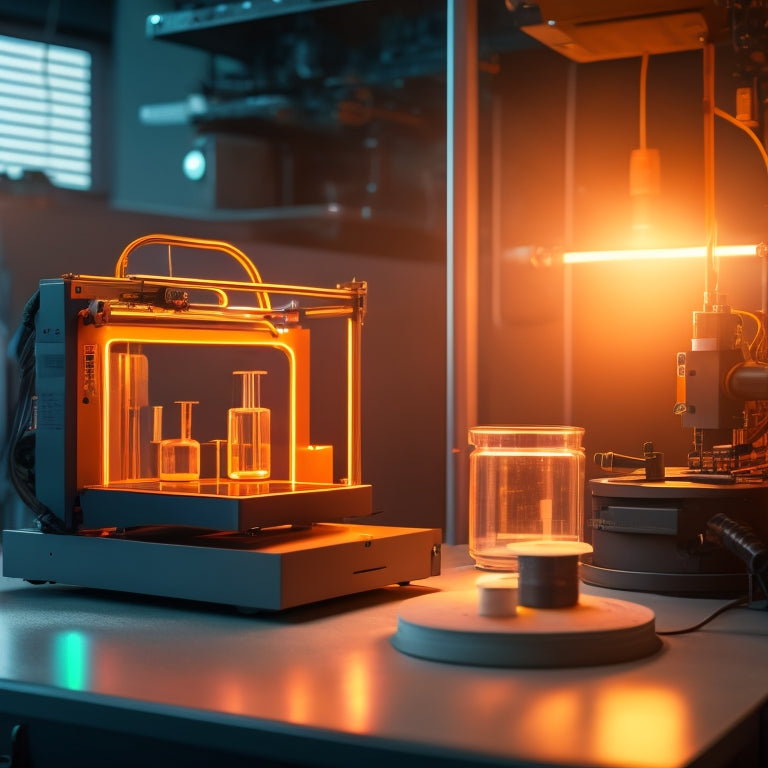
Newspaper Headline: "Revolutionary 3D Filament: High Heat Tolerance
Share
A revolutionary 3D filament has been developed, featuring high heat tolerance up to 110°C and odorless, BPA-free properties. This innovative material enables the creation of durable, functional parts for various industries, including sustainable designs, customized prototypes, and reusable products. Its high mechanical strength, chemical resistance, and durability make it an ideal choice for industrial applications. To optimize its performance, proper filament storage, strong bed adhesion, and medium to slow print speeds are recommended. Further exploration of this cutting-edge technology reveals its vast potential for transforming various sectors.
Key Takeaways
• CPE HT 3D filament enables creation of functional and durable parts with high heat tolerance, perfect for industrial applications.
• It withstands elevated temperatures up to 110°C, making it ideal for appliance housings and spare parts.
• The filament is odorless, BPA-free, and has high mechanical strength, suitable for creating innovative utility prototypes.
• CPE HT promotes sustainable designs, reduces waste, and supports eco-friendly practices, making a real impact in various sectors.
• It offers vast potential for industrial applications, pushing boundaries of 3D printing and enabling the creation of functional and sustainable products.
Applications in 3D Printing
Utilizing CPE HT 3D filament in various applications enables the creation of functional and durable parts, suitable for a range of uses, from home and children's articles to household appliances. This versatile material allows for the development of sustainable designs, reducing waste and promoting eco-friendly practices.
In addition, CPE HT's high heat tolerance makes it an ideal choice for customized prototypes, such as appliance housings and spare parts, that require withstanding elevated temperatures. The possibilities are endless, from creating reusable dishes and toys to designing innovative utility prototypes.
With CPE HT, the boundaries of 3D printing are pushed, enabling the creation of functional, durable, and sustainable products that make a real impact.
CPE HT Properties and Benefits
CPE HT 3D filament boasts an impressive array of properties and benefits, including temperature resistance up to 110°C, odorlessness, and freedom from BPA, BPS, and styrenes. This innovative material offers several durability advantages, making it an ideal choice for industrial applications.
Here are three key benefits that set CPE HT apart:
-
Unparalleled heat resistance: With a temperature tolerance of up to 110°C, CPE HT is perfect for applications where high heat is a concern.
-
Mechanical strength: CPE HT's high mechanical strength ensures that printed parts can withstand demanding conditions.
-
Chemical resistance: This filament's resistance to chemicals and corrosive substances makes it suitable for use in harsh environments.
With its unique combination of properties, CPE HT is poised to revolutionize the 3D printing industry, opening up new possibilities for industrial applications where durability and heat tolerance are critical.
Printing and Handling Guidelines
To successfully harness the benefits of CPE HT, it is vital to follow specific guidelines for printing and handling this high-heat tolerant filament. Proper filament storage is essential to maintain its temperature resistance and material durability. Store CPE HT in a cool, dry place, away from direct sunlight.
| Printing Techniques | Recommendations |
|---|---|
| Bed Adhesion | Strong adhesion to the bed, use masking tape |
| Print Speed | Medium to slow print speed for best results |
| Temperature | Ideal temperature range: 240-260°C |
Frequently Asked Questions
Is CPE HT Safe for Printing Objects That Come Into Contact With Food?
'As the old adage goes, 'an ounce of prevention is worth a pound of cure.'
When it comes to printing objects that come into contact with food, safety is paramount. CPE HT, with its temperature resistance up to 110°C, BPA, BPS, and styrene-free properties, meets the standards for Food Grade materials.
Its high mechanical strength and odorless nature make it an ideal choice for kitchen safety.
Rest assured, CPE HT is a reliable option for printing food storage containers and reusable dishes, ensuring a safe and healthy kitchen environment.'
Can CPE HT Be Used for Outdoor Applications Exposed to Sunlight?
In outdoor applications exposed to sunlight, CPE HT's UV resistance is a vital consideration. While it exhibits excellent temperature resistance up to 110°C, its weathering effects under prolonged UV exposure are not explicitly stated.
However, its high mechanical strength and temperature resistance suggest potential suitability for outdoor use. Further testing and research are recommended to determine its long-term performance and potential degradation under UV radiation.
How Does CPE HT Compare to PLA in Terms of Print Speed?
As the printing world discusses 'PLA, who?' in the face of CPE HT's heat tolerance revolution, we explore the print speed comparison.
Unlike PLA, CPE HT's superior layer adhesion and adjustable infill density allow for faster print speeds without compromising structural integrity. This translates to reduced print times and increased productivity.
While PLA may still hold its own in certain applications, CPE HT's advanced properties make it the clear winner in the speed department.
Is CPE HT Compatible With All 3D Printing Software and Slicers?
When it comes to the compatibility of CPE HT with 3D printing software and slicers, it is important to take into account software limitations and printer compatibility.
While CPE HT is generally compatible with most 3D printing software, some slicers may require specific settings or configurations to optimize print quality.
It is vital to consult the manufacturer's guidelines and recommended settings for seamless integration with your 3D printing setup.
Can CPE HT Be Post-Processed or Painted for Added Durability?
Like a master chef seasoning a dish, post-processing can elevate CPE HT's durability.
Yes, CPE HT can be post-processed or painted for added durability. Aesthetic coatings, such as varnishes or lacquers, can enhance its appearance, while chemical treatments can further improve its mechanical strength.
These processes can be applied using various methods, including spraying, brushing, or dipping, to achieve the desired level of durability and visual appeal.
Related Posts
-

10 Essential Storage Hacks for College Dorms
You'll need to get creative with storage to make the most of your college dorm room's limited space. Start by maximiz...
-

Simplify and Streamline Your Small Entryway Chaos
You're ready to tame the chaos in your small entryway! Start by gathering three labeled boxes to categorize clutter, ...

